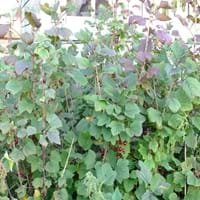Life Span
Not Available
Perennial
Origin
Hybrid origin
Asia, Europe, North America
Types
Not Available
Black Ash, Blue Ash, California Ash, Carolina Ash, European Ash
Number of Varieties
Not Available
Habitat
Clay soil areas, Loamy soils, Sandy areas, Well Drained
Forest edges, Hillside, Woods
USDA Hardiness Zone
5-9
3-9
Sunset Zone
A1, A2, A3, 1a, 1b, 2a, 2b, 3a, 3b, 4, 5, 6, 7
9, 12, 13, 14, 15, 16, 17, 18, 19, 20, 21, 22, 23, 24
Habit
Upright/Erect
Oval or Rounded
Flower Color
Green, Purple
White
Flower Color Modifier
Bicolor
Not Available
Fruit Color
Red, Purple, Burgundy, Black
Not Available
Leaf Color in Spring
Green
Dark Green
Leaf Color in Summer
Green
Dark Green
Leaf Color in Fall
Green
Dark Green
Leaf Color in Winter
Light Green
Dark Green
Leaf Shape
Palmate
Oblovate
Plant Season
Summer, Fall
All year
Sunlight
Full Sun, Partial Sun, Partial shade
Full Sun, Part sun
Type of Soil
Clay, Loam, Sand
Loamy, Sandy
The pH of Soil
Acidic, Neutral, Alkaline
Acidic
Soil Drainage
Well drained
Well drained
Bloom Time
Spring
Late Spring, Spring
Tolerances
Drought
Drought, Pollution, Soil Compaction
Where to Plant?
Ground
Ground
How to Plant?
Budding, Seedlings, Stem Cutting
Grafting, Seedlings, Stem Planting, Transplanting
Plant Maintenance
Medium
Medium
Watering Requirements
Allow to dry out slightly between watering, Do not water frequently
Does not require lot of watering, Medium, Prefer drip-irrigation instead of Over-head watering
In Summer
Lots of watering
Lots of watering
In Spring
Moderate
Moderate
In Winter
Average Water
Average Water
Soil pH
Acidic, Neutral, Alkaline
Acidic
Soil Type
Clay, Loam, Sand
Loamy, Sandy
Soil Drainage Capacity
Well drained
Well drained
Sun Exposure
Full Sun, Partial Sun, Partial shade
Full Sun, Part sun
Pruning
Do not prune during shooting season, Remove damaged leaves, Remove dead branches, Remove dead leaves, Thinning
Prune in winter, Prune prior to new growth
Fertilizers
Apply N-P-K, since leafy plants, use higher nitrogen content fertilizer
All-Purpose Liquid Fertilizer
Pests and Diseases
Birds, Leaf spot, Red blotch
Bark splits, Crown gall, Epicormic Sprouting, Woodpecker feeding
Plant Tolerance
Drought
Drought
Flowers
Insignificant
Yes
Flower Petal Number
Single
Single
Foliage Texture
Medium
Medium
Foliage Sheen
Glossy
Glossy
Allergy
Not Available
Not Available
Aesthetic Uses
Cottage Garden
Not Used For Aesthetic Purpose
Beauty Benefits
Not Available
Not Available
Environmental Uses
Air purification
Air purification
Medicinal Uses
Not Available
Fever, Liver problems
Part of Plant Used
Fruits
Leaves, Stem
Other Uses
Used As Food
Used as Ornamental plant
Used As Indoor Plant
No
No
Used As Outdoor Plant
Yes
Yes
Garden Design
Edible, Fruit / Fruit Tree, Hedges, Mixed Border
Shady Tree, Showy Tree
Botanical Name
RIBES x culverwellii
Fraxinus
Common Name
Jostaberry
Ash Tree
In Hindi
Jostaberry
राख पेड़
In German
Jostaberry
Esche
In French
casseille
Frêne
In Spanish
Jostaberry
Fresno
In Greek
Jostaberry
δέντρο Ash
In Portuguese
Jostaberry
Freixo
In Polish
Jostaberry
Jesion
Phylum
Magnoliophyta
Anthophyta
Class
Equisetopsida
Magnoliopsida
Order
Saxifragales
Lamiales
Family
Grossulariaceae
Oleaceae
Clade
Angiosperms, Core eudicots, Eudicots
Angiosperms, Asterids, Eudicots
Tribe
Not Available
Oleeae
Subfamily
Not Available
Not Available
Importance of Jostaberry and Ash Tree
Want to have the most appropriate plant for your garden? You might want to know the importance of Jostaberry and Ash Tree. Basically, these two plants vary in many aspects. Compare Jostaberry and Ash Tree as they differ in many characteristics such as their life, care, benefits, facts, etc. Every gardener must at least have the slightest clue about the plants he wants to plant in his garden. Compare their benefits, which differ in many ways like facts and uses. The medicinal use of Jostaberry is Not Available whereas of Ash Tree is Fever and Liver problems. Jostaberry has beauty benefits as follows: Not Available while Ash Tree has beauty benefits as follows: Not Available.
Compare Facts of Jostaberry vs Ash Tree
How to choose the best garden plant for your garden depending upon its facts? Here garden plant comparison will help you to solve this query. Compare the facts of Jostaberry vs Ash Tree and know which one to choose. As garden plants have benefits and other uses, allergy is also a major drawback of plants for some people. Allergic reactions of Jostaberry are Not Available whereas of Ash Tree have Not Available respectively. Having a fruit bearing plant in your garden can be a plus point of your garden. Jostaberry has showy fruits and Ash Tree has no showy fruits. Also Jostaberry is not flowering and Ash Tree is flowering. You can compare Jostaberry and Ash Tree facts and facts of other plants too.





